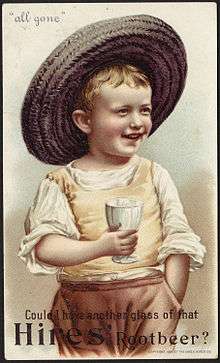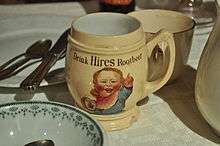Hires Root Beer
 | |
| Type | Root Beer |
|---|---|
| Manufacturer | Dr Pepper Snapple Group |
| Country of origin | United States |
| Introduced | 1876 |
| Color | Caramel |
| Related products | A&W Root Beer, Dad's Root Beer, Mug Root Beer, Barq's |
| Website | Dr Pepper Snapple Group |
Hires Root Beer is a soft drink which is marketed by Dr Pepper Snapple Group. Introduced in 1876, it is considered the second longest continuously made soft drink in the United States. Only Vernor's Ginger Ale, dating to 1866, is older.
History

Hires Root Beer was created by Philadelphia pharmacist Charles Elmer Hires. The official story is that Hires first tasted root beer, a traditional American beverage dating back to the colonial era, while on his honeymoon in 1875.[1] However, historical accounts vary and the actual time and place of the discovery may never be known.[2] By 1876, Hires had developed his own recipe and was marketing 25-cent packets of powder which each yielded five gallons of root beer. At Philadelphia's Centennial Exposition in 1876, he cultivated new customers by giving away free glasses of root beer. Hires marketed it as a solid concentrate of sixteen wild roots and berries. It claimed to purify the blood and make rosy cheeks.[3] In 1884, he began producing a liquid extract and a syrup for use in soda fountains, and was soon shipping root beer in kegs and producing a special fountain dispenser called the "Hires Automatic Munimaker." In 1890, the Charles E. Hires Company incorporated and began supplying Hires root beer in small bottles[4][5] claiming over a million bottles sold by 1891.[6]
But Hires's choice of name for his product caused a problem: the word "beer" drew the wrath of the temperance movement. He had his root beer tested by a laboratory, and trumpeted their conclusion that a glass of his root beer contained less alcohol than a loaf of bread. Hires Root Beer was promoted as "The Temperance Drink" and "the Greatest Health-Giving Beverage in the World." Hires advertised aggressively, believing "doing business without advertising is like winking at a girl in the dark. You know what you are doing, but nobody ELSE does."[1]

One of the major ingredients of root beer was sassafras oil, a plant root extract used in beverages for its flavor and presumed medicinal properties. The medicinal properties of root beer are emphasized in the advertising slogan, "Join Health and Cheer/Drink Hires Rootbeer." Ironically, the U.S. Food and Drug Administration banned sassafras oil in 1960 because it contains the carcinogen and liver-damaging chemical safrol. However, a process was later discovered by which the harmful chemical could be removed from sassafras oil while preserving the flavor.[7]
Hires Root Beer kits, available in the United States and Canada from the early 1900s through the 1980s allowed consumers to mix an extract with water, sugar and yeast to brew their own root beer. However, most consumption was of pre-bottled root beer.
A mid-1960s' advertising campaign featured jingles by jazz singer Blossom Dearie, wherein she sang in a Betty-Boop voice: "Hires Root Beer! Hires Rootin' Tootin' Root Beer! Hires Rootin'-Tootin' Rabble-Rousin', lion-roarin', Roman-candle-lightin' Root Beer!"
Today
Consolidated Foods bought the company from the Hires family in 1960, only to sell Hires two years later to Crush International. Procter & Gamble bought Crush in 1980, and sold it to Cadbury Schweppes in 1989. Cadbury divested its soft drinks arm in 2008, and the beverage company renamed itself Dr Pepper Snapple Group that year.
In Canada, the Hires brand is no longer sold by Dr Pepper Snapple Group; retailers and vending machines have replaced it with Pepsi-owned Mug Root Beer since the 1990s. Hires availability in the US is limited as other Dr. Pepper owned brands like A&W Root Beer are competing for the same bottlers on behalf of the same company.[8]
An unrelated drive-in restaurant chain in Utah, Hires Big H, offers "The Big H Root Beer Extract", a modern version of the "Hires Root Beer kit" unsweetened concentrate;[9] would-be home brewers too impatient to carbonate the old-fashioned way using sugar and yeast could use dry ice as a more rapid source of carbon dioxide.
See also
- Chester teapot, a large teapot made from a former giant Hires Root Beer barrel sign
Notes
- Hires, C.E. 1913. Seeing opportunities. American Druggist and Pharmaceutical Record. American Druggist Publ. Co., New York. ISSN 0099-7366.
- Quarantiello, L. 1997. The Root Beer Book: A Celebration of America's Best-Loved Soft Drink. Tiare Publ., Lake Geneva, WI. ISBN 978-0-936653-78-5.
References
- 1 2 "Our Brands". Dr Pepper Snapple Group. Retrieved 2014-08-22.
- ↑ Bennett, Eileen (June 28, 1998). "Local Historians Argue Over the Root of Hires". The Press of Atlantic City. Retrieved 2014-08-22.
- ↑ Pendergrast, Mark (2000). For God, Country and Coca-Cola. Basic Books. p. 14. ISBN 978-0-46505-468-8. Retrieved 2014-08-22.
- ↑ Funderburg, Anne Cooper (2001). Sundae best: a history of soda fountains. Bowling Green, Ohio: Bowling Green University Popular Press. pp. 92–94. ISBN 978-0-87972-854-0. Retrieved 2014-08-22.
- ↑ Hoolihan, Christopher (2001). Social Medicine in the United States, 1717-1917. Boydell & Brewer. p. 454. ISBN 978-1-58046-098-9. Retrieved 2014-08-22.
- ↑ "Hires Root Beer". Lowcountry Digital Library. Retrieved 1 September 2014.
- ↑ Nickell, Joe (January–February 2011). "'Pop' Culture: Patent Medicines Become Soft Drinks". Skeptical Inquirer. Committee for Skeptical Inquiry. 35 (1): 14–17. Retrieved 2014-08-22.
- ↑ "Killing A Product – The Demise of Hires Root Beer". Stuff Nobody Cares About. 22 August 2011. Retrieved 2014-08-22.
- ↑ "Homemade Root Beer Recipe". Hires Big H. Retrieved 2014-08-22.